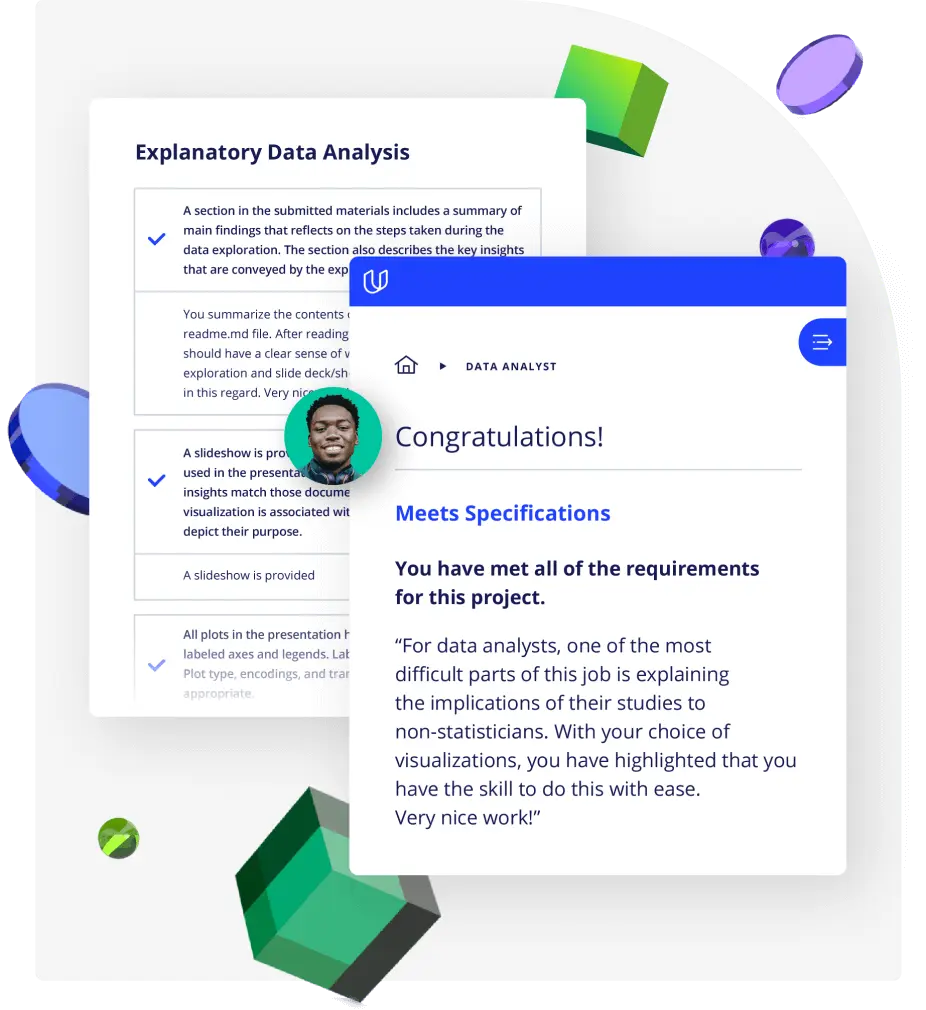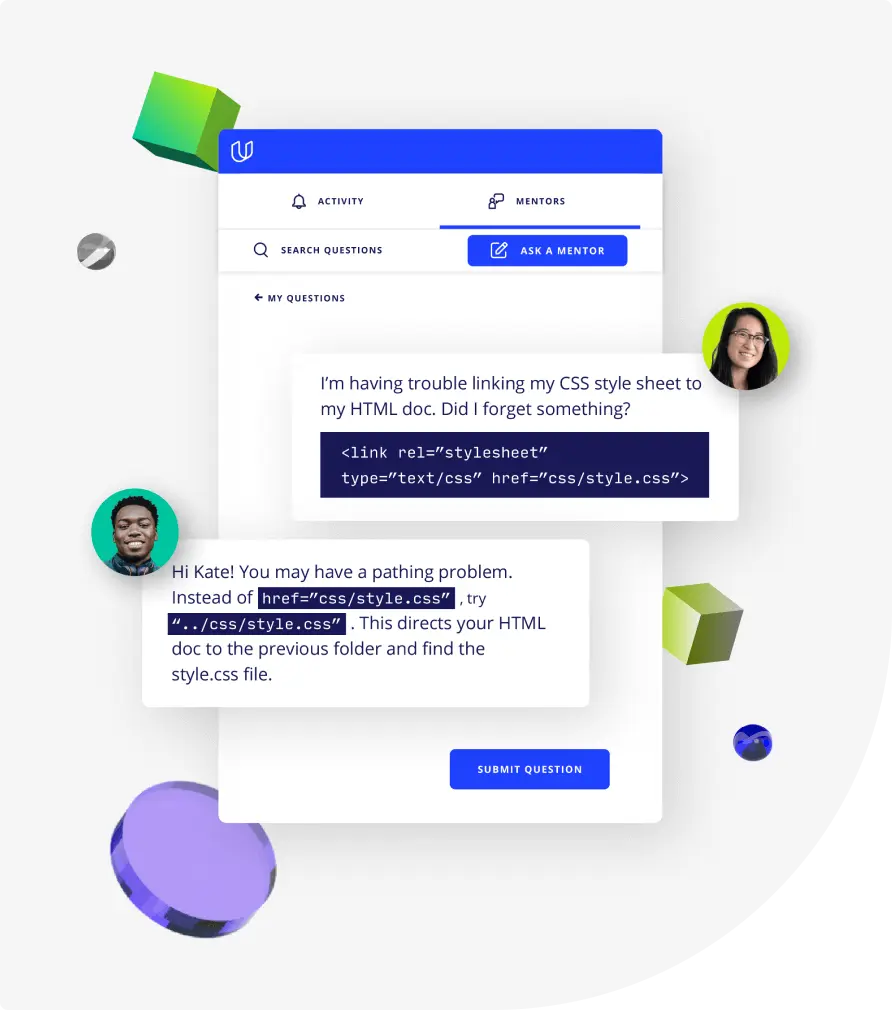Lesson 1
Welcome!
Welcome to Udacity. Takes 5 minutes to get familiar with Udacity courses and gain some tips to succeed in courses.

Nanodegree Program
In this program, you will embark on a comprehensive exploration of Embedded Systems Essentials, focusing on Digital Output Devices and Analog Signals, Voltage, ADCs and Signal Processing, as well as Embedded Systems Design and Debugging. Through a combination of theoretical knowledge and practical hands-on exercises, you will gain a deep understanding of the fundamental concepts in embedded systems. You will learn how to interface with digital output devices, work with analog signals, and process voltage and data using ADCs.
In this program, you will embark on a comprehensive exploration of Embedded Systems Essentials, focusing on Digital Output Devices and Analog Signals, Voltage, ADCs and Signal Processing, as well as Embedded Systems Design and Debugging. Through a combination of theoretical knowledge and practical hands-on exercises, you will gain a deep understanding of the fundamental concepts in embedded systems. You will learn how to interface with digital output devices, work with analog signals, and process voltage and data using ADCs.
Beginner
4 weeks
Real-world Projects
Completion Certificate
Last Updated June 8, 2024
No experience required
Course 1 • 45 minutes
Welcome to Udacity! We're excited to share more about your Nanodegree program and start this journey with you!
Lesson 1
Welcome to Udacity. Takes 5 minutes to get familiar with Udacity courses and gain some tips to succeed in courses.
Lesson 2
You are starting a challenging but rewarding journey! Take 5 minutes to read how to get help with projects and content.
Course 2 • 8 hours
This course covers the essentials of digital output devices. Different types of digital displays are examined before taking a closer look at seven-segment displays. Next up are analog signals, followed by an introduction to Ohm's Law, which will help you understand the relationship between voltage, current, and resistance.
Lesson 1
This lesson explores the wide range of digital output devices and play technologies, each designed for particular applications, from basic bar LEDs to dynamic, full-colour displays.
Lesson 2
Learn about the seven-segment displays' evolution and applications, covering common anode/cathode configurations and scanning techniques.
Lesson 3
In this lesson, you will learn analog signals in embedded systems, their conversion to digital via ADCs, the maths behind it and put that into practice through a sensor exercise.
Lesson 4
The Ohm's Law is a fundamental subject in electronics. To lay the foundation, this lesson covers the concepts of voltage, current and resistance before explaining their relationship.
Course 3 • 8 hours
In this course, you will explore the essentials of voltage dividers, variable resistors, analog-to-digital converters (ADCs), and signal processing. You will gain a solid understanding of voltage division principles and how to design and implement voltage dividers effectively. You will also learn how variable resistors can be utilized to control electrical circuits and adjust signal levels.
Lesson 1
This lesson covers voltage dividers. In it, you will learn Conservation of Charge, Kirchhoff's Laws, and design dividers, as well as their usage and limitations in embedded systems.
Lesson 2
Explore the dynamic world of variable resistors, covering potentiometers, resistive sensors like thermistors and photoresistors, and their roles in electronic systems.
Lesson 3
Discover ADC fundamentals, operation, types (Flash, SAR), key parameters (resolution, sampling frequency), ratiometric values, and application in embedded systems.
Lesson 4
Processing signals is essential to handling signals in real embedded systems. This lesson will explore different methods of processing, dive into filtering and apply signal processing to real systems.
Course 4 • 6 hours
This course will cover processing that is triggered by interrupts, as well as the basics of how to design and debug an embedded system. You will finish with a project to create an embedded voltmeter.
Lesson 1
This lesson provides a deeper understanding of how interrupts function in embedded systems as well as how they can be used to process events.
Lesson 2
Good design always precedes good implementation. In this lesson some fundamental guidelines of design will be discussed and applied to system and subsystem design.
Lesson 3
This lesson discusses several different ways engineers commonly approach discovering and resolving issues in embedded systems, including LED debugging, logging, and the use of a debugger.

Senior Software Engineer at Amazon
Adam St. Amand is a senior software engineer at Amazon working on Project Kuiper, where he's helped develop satellite flight software, terrestrial terminals, as well as mobile receivers for aeronautical applications. Previously he worked at NASA's Jet Propulsion Lab as a flight software engineer for the Europa Clipper mission. He graduated from the University of Colorado, Boulder.

Embedded Systems Consultant
Ozgur has a 20+ years experience in the embedded systems field with exposure to products in different domains from home entertainment to industrial control, healthcare and automotive. As well as developing professional systems, he is also passionate about learning and explaining complex concepts in simple ways.
Combine technology training for employees with industry experts, mentors, and projects, for critical thinking that pushes innovation. Our proven upskilling system goes after success—relentlessly.

Demonstrate proficiency with practical projects
Projects are based on real-world scenarios and challenges, allowing you to apply the skills you learn to practical situations, while giving you real hands-on experience.
Gain proven experience
Retain knowledge longer
Apply new skills immediately

Top-tier services to ensure learner success
Reviewers provide timely and constructive feedback on your project submissions, highlighting areas of improvement and offering practical tips to enhance your work.
Get help from subject matter experts
Learn industry best practices
Gain valuable insights and improve your skills

Unlimited access to our top-rated courses
Real-world projects
Personalized project reviews
Program certificates
Proven career outcomes
Full Catalog Access
One subscription opens up this course and our entire catalog of projects and skills.
Average time to complete a Nanodegree program
4 weeks
, Beginner
4 weeks
, Beginner
8 hours
, Beginner
6 hours
, Beginner
4 weeks
, Beginner
8 hours
, Beginner
(729)
3 months
, Intermediate
8 hours
, Beginner
8 hours
, Beginner
8 hours
, Beginner
4 weeks
, Beginner
4 weeks
, Beginner
6 hours
, Beginner
3 hours
, Beginner
8 hours
, Beginner

Connecting to Hardware
4 weeks
, Beginner
4 weeks
, Beginner
8 hours
, Beginner
6 hours
, Beginner
4 weeks
, Beginner
8 hours
, Beginner
(729)
3 months
, Intermediate
8 hours
, Beginner
8 hours
, Beginner
8 hours
, Beginner
4 weeks
, Beginner
4 weeks
, Beginner
6 hours
, Beginner
3 hours
, Beginner
8 hours
, Beginner